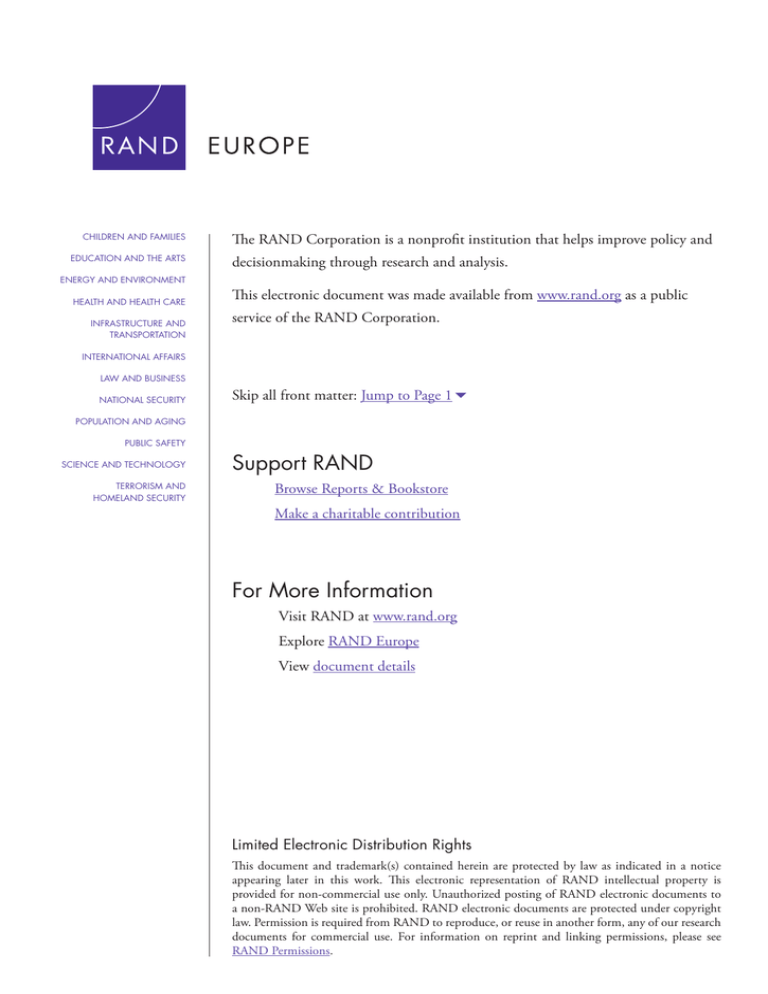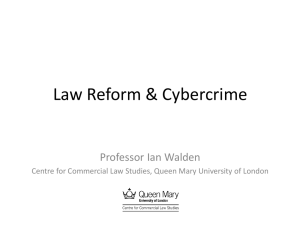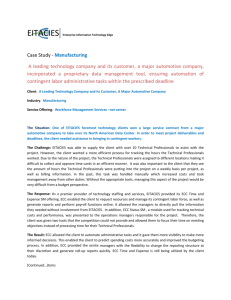
CHILDREN AND FAMILIES
EDUCATION AND THE ARTS
The RAND Corporation is a nonprofit institution that helps improve policy and
decisionmaking through research and analysis.
ENERGY AND ENVIRONMENT
HEALTH AND HEALTH CARE
INFRASTRUCTURE AND
TRANSPORTATION
This electronic document was made available from www.rand.org as a public
service of the RAND Corporation.
INTERNATIONAL AFFAIRS
LAW AND BUSINESS
NATIONAL SECURITY
Skip all front matter: Jump to Page 16
POPULATION AND AGING
PUBLIC SAFETY
SCIENCE AND TECHNOLOGY
TERRORISM AND
HOMELAND SECURITY
Support RAND
Browse Reports & Bookstore
Make a charitable contribution
For More Information
Visit RAND at www.rand.org
Explore RAND Europe
View document details
Limited Electronic Distribution Rights
This document and trademark(s) contained herein are protected by law as indicated in a notice
appearing later in this work. This electronic representation of RAND intellectual property is
provided for non-commercial use only. Unauthorized posting of RAND electronic documents to
a non-RAND Web site is prohibited. RAND electronic documents are protected under copyright
law. Permission is required from RAND to reproduce, or reuse in another form, any of our research
documents for commercial use. For information on reprint and linking permissions, please see
RAND Permissions.
This product is part of the RAND Corporation technical report series. Reports may
include research findings on a specific topic that is limited in scope; present discussions
of the methodology employed in research; provide literature reviews, survey instruments, modeling exercises, guidelines for practitioners and research professionals, and
supporting documentation; or deliver preliminary findings. All RAND reports undergo rigorous peer review to ensure that they meet high standards for research quality
and objectivity.
Feasibility Study for a
European Cybercrime
Centre
Neil Robinson, Emma Disley, Dimitris Potoglou,
Anaïs Reding, Deirdre May Culley, Maryse Penny,
Maarten Botterman, Gwendolyn Carpenter,
Colin Blackman, Jeremy Millard
Prepared for the European Commission, Directorate-General Home Affairs,
Directorate Internal Security Unit A.2: Organised Crime
EUROPE
This study has been carried out for the Directorate-General Home Affairs in the
European Commission as result of the procurement procedure
HOME/2010/ISEC/FC/059-A2 for an amount of € 169.400,00.
The report expresses the opinion of the contractor (consortium of Danish
Technological Institute, RAND Europe Cambridge Ltd, ICEG European Research
and Consulting Ltd and GNKS Consult BV) who performed the study. These views
have not been adopted or in any way approved by the European Commission and
should not be relied upon as a statement of the European Commission's or the
Home Affairs DG's views. The European Commission does not guarantee the
accuracy of the information given in the study, nor does it accept responsibility for
any use made thereof.
Copyright in this study is held by the European Union. Persons wishing to use the
contents of this study (in whole or in part) for purposes other than their personal use
are invited to submit a written request to the following address:
European Commission
DG Home Affairs, Directorate A
Rue du Luxembourg 46
B-1049 Brussels
HOME-PROCUREMENT-A4@ec.europa.eu
RAND Europe is an independent, not-for-profit research organisation whose mission is
to improve policy and decision making for the public good. RAND’s publications do not
necessarily reflect the opinions of its research clients and sponsors.
R® is a registered trademark.
© Copyright 2012 European Commission
All rights reserved. No part of this book may be reproduced in any form by any electronic
or mechanical means (including photocopying, recording, or information storage and
retrieval) without permission in writing from the European Commission.
Published 2012 by the RAND Corporation
1776 Main Street, P.O. Box 2138, Santa Monica, CA 90407-2138
1200 South Hayes Street, Arlington, VA 22202-5050
4570 Fifth Avenue, Suite 600, Pittsburgh, PA 15213-2665
Westbrook Centre, Milton Road, Cambridge CB4 1YG, United Kingdom
RAND URL: http://www.rand.org
RAND Europe URL: http://www.rand.org/randeurope
To order RAND documents or to obtain additional information, contact
Distribution Services: Telephone: (310) 451-7002;
Fax: (310) 451-6915; Email: order@rand.org
Executive summary
Background
Internet access is attended by criminal activities that exploit online transactions and
the reach that the Internet affords
Cybercrime is an increasingly important concern for policy-makers, businesses and citizens
alike. In many countries, societies have come to rely on cyberspace to do business, consume
products and services or exchange information with others online. By 2011, nearly three
quarters (73 percent) of European households had Internet access at home and in 2010 over
third of EU citizens (36 percent) were banking online. Modes of connecting are growing ever
more complex too. Smartphones can access high-speed data networks, enabling people to surf
the Internet when on the move, and developments such as cloud computing are helping to
realise the possibilities of limitless data storage.
The benefits of cyberspace are accompanied by a downside, however. Criminals exploit citizens
and organisations to steal money, to commit fraud or for other criminal activities, including
identity theft. These can range from a type of fraud called “phishing” that fools users into
revealing passwords or sensitive data to complex incidents involving breaking into computer
networks to steal data such as business secrets or money. Some misuses aim to destroy
information or deny its availability to others, motivated not by money but by anger or
ideology. Many cybercrimes target financial institutions or online entities where transactions
take place (for example, the EU’s own Emissions Trading Scheme). Still other types of
cybercrime may focus on personal data. According to the Organisation for Economic Cooperation and Development (OECD), personal data has become the lifeblood of the Internet
economy, so thieves know that by finding such data they can either sell it on or use it to target
victims. Some types of cybercrime revolve around activities that have a direct or indirect
physical element of harm against the person – for example the online exchange of child abuse
material. There are crimes that exist only in cyberspace: online bullying or stalking via virtual
communities such as Second Life have been documented.
Measurement of extent and costs of cybercrime remains a challenge, though EU
agencies Europol and Eurojust are making progress in training and data
infrastructure needed to make accurate assessments
It is difficult to estimate precisely the real extent or costs of cybercrime. Industry predictions
are that it runs into the hundreds of millions of Euros per year. Official reports and criminal
justice statistics paint a much different picture with small numbers of incidents. Regardless, the
trends are that the phenomenon is increasing. Measurement is complicated by two factors.
Firstly, separating true cybercrime from fraud is complex. Secondly, there are low levels of
reporting. Citizens are confronted with myriad ways to report cybercrime. Businesses might be
reluctant lest it affect their share price or cause reputational damage.
Contract: HOME/2010/ISEC/FC/059-A2
1
Feasibility study for a European Cybercrime Centre: Final report
RAND Europe
These activities have not gone ignored, however. At a European level, Europol, the EU’s own
criminal intelligence organisation, has had an emergent capability to address cybercrime for
some time. Europol has strict data-protection arrangements in place, which means it can
process personal data when supporting Member State operational investigations alongside the
European Judicial Co-operation Unit (Eurojust). Europol is also driving training and best
practice provision for addressing cybercrime, in conjunction with training partners such as the
European Police College (CEPOL). In addition, Europol has an extensive infrastructure for
collecting, analysing and processing sensitive criminal intelligence and investigative data.
Many Member States have a specialised law enforcement unit set up to address cybercrime.
These units often conduct operational support activities and forensics, as well as providing
training and sometimes working alongside the private sector. They can focus on different
aspects or types of cybercrime; often they are under pressure from budgets and requests from
other criminal investigations where their forensic capability is in demand.
Capability must be broadened and collaboration mechanisms strengthened to
improve information-sharing and data collection, and expand expertise for complex
cases
However, challenges remain. Not least is the uncertainty about the importance of reliable data
and the pursuant need to establish better co-operation models between law enforcement agents
and others, especially those in the private sector such as banks, communications providers and
CERTs. There is also a need to broaden capability to ensure that specialised units can focus on
the more complex or serious cases. Cybercriminals can leverage poor co-operation between
different countries – this is especially true for those countries that “export” cybercrime.
With this in mind, policy-makers have taken considerable interest in identifying ways to
improve the situation. In April 2010, the European Council discussed the possibility of a
European Cybercrime Centre (ECC), to be set up by 2013, to build analytical and operational
capacity to tackle cybercrime. The subsequent Internal Security Strategy foresaw that an ECC,
established within existing structures, would thus act as Europe’s focal point in the fight
against cybercrime.
A European Cybercrime Centre could address many of the current challenges but
requires careful assessment with respect to most suitable options in terms of
feasibility, costs, mandate, risks and relationship to other organisations
In order to assess its feasibility, a consortium led by RAND Europe was asked by the European
Commission to conduct a two-part study: firstly, to assess and evaluate the state of current
efforts to deal with cybercrime, and, secondly, to consider the feasibility of an ECC across a
range of different aspects such as mandate, resources, activities, risks, impact and
interoperability with other organisations.
After considering a range of options, the study team looked at four in detail:
•
Maintaining the status quo
•
An ECC owned by Europol
•
An ECC hosted but not owned by Europol
•
A virtual ECC
Contract: HOME/2010/ISEC/FC/059-A2
2
RAND Europe
Executive summary
Our conclusions were that an ECC should deploy resources in a targeted fashion. For example,
expanding training efforts would help Member States in dealing with the broad range of frauds
and crimes perpetrated with the aid of computers. Criminal intelligence efforts should be
dedicated to addressing the most serious forms of cybercrime. There was limited difference in
the resource implications across each option. Out of the four options we chose for specific
consideration, there was limited difference in cost. However, there were major differences in
institutional complexity and the organisational parameters between the different options. An
ECC should continue to strengthen Europol’s analytical capability for criminal intelligence
and operational support, whilst facilitating new forms of collaborative working at the Member
State level, between law enforcement and national/governmental CERTs.
The ECC should be run according to a model that places it in the middle of a broad capability
to tackle cybercrime, exploiting the strengths of each organisation that possesses existing
competencies, skills and knowledge. This does not necessarily mean seting up a wholly new
organisation to deliver such a capability. Rather the feasibility of the ECC should be
considered with respect to doing so with minimal organisational change. A European
cybercrime capability would be at the disposal of the Member States and the ECC would be
able to further support the work of the EUCTF.
We identified four sets of activities that the ECC should bring together in this capability based
approach:
•
Providing criminal intelligence analysis and operational support to Member State
investigations, building upon the established track record and unique competencies of
Europol and Eurojust.
•
Broad based training, education and professional development for all members of the
criminal justice community, by leveraging the role of CEPOL and the content and
training legacy established by ECTEG. Such training would include primarily week
long courses offered to help great a minimum baseline of familiarity with cybercrime
and crimes where there is an IT aspect.
•
Co-operation, collaboration and outreach with a broader set of non-criminal justice
stakeholders including the private sector but specifically national/governmental
CERTs through the establishment of joint CERT-LEA Liaison Officers co-funded
from the ECC with the input of ENISA. In addition, we propose a European
Cybercrime Resource Facility to act as a one stop shop for cybercrime knowledge
exchange and best practice sharing. This co-operation and collaboration would help
inform a much broader multi-source intelligence picture. In turn, through the work of
a new Data Fusion Unit, this would allow a more strategic criminal intelligence
analysis and operational support capacity.
•
Facilitating a common, standards based reporting platform to support the sharing of
cybercrime data, in a decentralised fashion, between members of the public and law
enforcement, private industry (such as financial institutions and CERTs) and between
law enforcement for cross border cases. Whilst the challenges of collaboration should
not be underestimated a good first step would be to invest in a mechanism that allows
the structured exchange of data. By analysing certain meta-elements the ECC could
thereby build up a picture of trends and patterns which would inform further
allocation of resources, intelligence and planning.
To estimate the resources required to perform these functions is no easy task. Regardless of
expected level of workload for intelligence analysis and operational support, we estimate that
3
Feasibility study for a European Cybercrime Centre: Final report
RAND Europe
three personnel would be required for the governance team, a further three for the European
Cybercrime Resource Facility (ECRF) and one for the initial stages of the Data Fusion Unit
(DFU). After the first year, during which we suggest a pilot of the Joint CERT-LEA Public
Private Partnership (PPP) Network in three Member States, we envisage that it would be
possible to discern a more precise idea of the likely resources needed to perform criminal
intelligence analysis and operational support activities. Other resources would be needed to
cover travel and subsistence for various meetings, an extensive expansion of the training and
professional development programme and other associated activities. However, since all of the
options under detailed consideration involved Europol (which has just opened its brand new
facility in The Hague) few additional one off costs are envisaged.
The risks associated with an ECC revolved around its visibility and institutional complexity.
Its impacts should be focused on measurable benefits for law enforcement rather than trying to
tackle the much broader aspect of cybersecurity. Finally, an ECC would need to work with a
range of partners from the public and private sector (particularly national/governmental
CERTs) including not only those within Europe but also others such as Interpol and third
countries.
Our final recommendation was that an ECC be set up within Europol.
We estimate that for the first (pilot) year between January and December 2013, a sum of
€3.36 million Euros would be required. This would cover the personnel for the ECC
governance team, ECRF, the pilot of the DFU and CERT-LEA PPP Pilot and expanded
training provision, travel, other operational costs, plus the development of a standards based
cybercrime reporting platform. Subsequently, this figure might rise (for example between €7
million and €42 million) if it seems that radically more criminal intelligence analysts and
operational support personnel are required, due to the increased information flow coming into
the DFU.
Considering impacts, we might envisage that the ECC could support in the handling of more
cases, but also the achievement of more intangible (but no less important) impacts including
better analysis of patterns, trends and data on the scale of the problem, smoother interaction
between law enforcement and the private sector (especially the CERT community)
importantly at the Member State but also the European level and enhanced co-operation with
international stakeholders (such as Interpol and third countries). As well as bringing
cybercriminals to justice, the ECC would no doubt work to make sure that Europe can fully
benefit from the potential contribution of cyberspace to economic growth and society as safely
as possible.
A staged approach is required based on clear principles
In conclusion, we base our recommendation and way forward around a number of key
principles. It is important to recognise two main structural considerations – firstly, that the
current climate of austerity weights heavily against new, expensive initiatives (such as the
creation of a brand-new physical building to house an ECC) and, secondly, that without a
wider information picture, it would be ineffectual to deploy further the resource of criminal
intelligence analysts. We also note the importance of adopting a broad-based capability
approach to addressing cybercrime, with the ECC at its heart, which would bring together
existing efforts from some of the public and private organisations we have considered. The
principles for implementation of an ECC include the following:
Contract: HOME/2010/ISEC/FC/059-A2
4
RAND Europe
Executive summary
•
The participation of Member States must be central to the efforts and impact of the
ECC.
•
The oversight and governance of the ECC must involve all key players including nonlaw enforcement partners.
•
The principle of subsidiarity must govern the scope of the ECC’s work.
•
The ECC should be flexible in focusing its resources depending on the type of
cybercrime.
•
The ECC must operate with respect for data protection and fundamental human
rights.
•
Greater co-operation between law enforcement and the national/governmental CERT
community will be crucial to the delivery of an improved cybercrime capability.
•
The ECC must support a broad-based capability within Member States.
•
The ECC must strengthen Europol’s existing capability based on a broader
information picture.
•
The ECC should set up a common infrastructure for reporting between many
different types of interested parties.
•
Over the long term, the ECC should work to develop an improved common picture
of the extent of the phenomena of cybercrime.
To achieve these high-level principles our proposed “pathfinder phase” in 2013 would lead to
Full Operating Capability in 2014. In particular, the initial phases would put in place
measures to inform more effective deployment of Europol’s valuable sensitive criminal
intelligence and operational support measures.
In the end, an ECC can bring together the strands of different organisational efforts to address
cybercrime in a combined pan-European capability.
5







